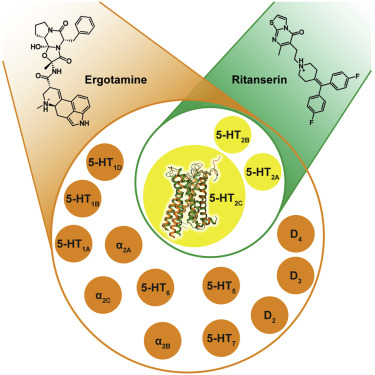Our official English website, www.x-mol.net, welcomes your
feedback! (Note: you will need to create a separate account there.)
5-HT2C Receptor Structures Reveal the Structural Basis of GPCR Polypharmacology.
Cell ( IF 45.5 ) Pub Date : 2018-Feb-08 , DOI: 10.1016/j.cell.2018.01.001 Yao Peng 1 , John D McCorvy 2 , Kasper Harpsøe 3 , Katherine Lansu 2 , Shuguang Yuan 4 , Petr Popov 5 , Lu Qu 6 , Mengchen Pu 7 , Tao Che 2 , Louise F Nikolajsen 8 , Xi-Ping Huang 9 , Yiran Wu 7 , Ling Shen 10 , Walden E Bjørn-Yoshimoto 3 , Kang Ding 10 , Daniel Wacker 2 , Gye Won Han 11 , Jianjun Cheng 7 , Vsevolod Katritch 5 , Anders A Jensen 3 , Michael A Hanson 12 , Suwen Zhao 10 , David E Gloriam 3 , Bryan L Roth 13 , Raymond C Stevens 14 , Zhi-Jie Liu 15
Cell ( IF 45.5 ) Pub Date : 2018-Feb-08 , DOI: 10.1016/j.cell.2018.01.001 Yao Peng 1 , John D McCorvy 2 , Kasper Harpsøe 3 , Katherine Lansu 2 , Shuguang Yuan 4 , Petr Popov 5 , Lu Qu 6 , Mengchen Pu 7 , Tao Che 2 , Louise F Nikolajsen 8 , Xi-Ping Huang 9 , Yiran Wu 7 , Ling Shen 10 , Walden E Bjørn-Yoshimoto 3 , Kang Ding 10 , Daniel Wacker 2 , Gye Won Han 11 , Jianjun Cheng 7 , Vsevolod Katritch 5 , Anders A Jensen 3 , Michael A Hanson 12 , Suwen Zhao 10 , David E Gloriam 3 , Bryan L Roth 13 , Raymond C Stevens 14 , Zhi-Jie Liu 15
Affiliation

|
Drugs frequently require interactions with multiple targets-via a process known as polypharmacology-to achieve their therapeutic actions. Currently, drugs targeting several serotonin receptors, including the 5-HT2C receptor, are useful for treating obesity, drug abuse, and schizophrenia. The competing challenges of developing selective 5-HT2C receptor ligands or creating drugs with a defined polypharmacological profile, especially aimed at G protein-coupled receptors (GPCRs), remain extremely difficult. Here, we solved two structures of the 5-HT2C receptor in complex with the highly promiscuous agonist ergotamine and the 5-HT2A-C receptor-selective inverse agonist ritanserin at resolutions of 3.0 Å and 2.7 Å, respectively. We analyzed their respective binding poses to provide mechanistic insights into their receptor recognition and opposing pharmacological actions. This study investigates the structural basis of polypharmacology at canonical GPCRs and illustrates how understanding characteristic patterns of ligand-receptor interaction and activation may ultimately facilitate drug design at multiple GPCRs.
中文翻译:

5-HT2C受体结构揭示了GPCR多药理学的结构基础。
药物经常需要通过称为多药理学的过程与多个靶标相互作用,以实现其治疗作用。当前,靶向几种5-羟色胺受体(包括5-HT 2C受体)的药物可用于治疗肥胖症,药物滥用和精神分裂症。开发选择性5-HT 2C受体配体或开发具有确定的多药理学特征的药物,尤其是针对G蛋白偶联受体(GPCR)的竞争挑战仍然极为困难。在这里,我们解决了5-HT 2C受体与高度混杂的激动剂麦角胺和5-HT 2A-C的两种结构受体选择性反向激动剂利坦色林,分辨率分别为3.0Å和2.7Å。我们分析了它们各自的结合姿势,以提供有关其受体识别和相反药理作用的机理见解。这项研究调查了规范GPCR上多药理学的结构基础,并阐明了如何理解配体-受体相互作用和激活的特征模式可能最终促进了多个GPCR上的药物设计。
更新日期:2018-02-01
中文翻译:

5-HT2C受体结构揭示了GPCR多药理学的结构基础。
药物经常需要通过称为多药理学的过程与多个靶标相互作用,以实现其治疗作用。当前,靶向几种5-羟色胺受体(包括5-HT 2C受体)的药物可用于治疗肥胖症,药物滥用和精神分裂症。开发选择性5-HT 2C受体配体或开发具有确定的多药理学特征的药物,尤其是针对G蛋白偶联受体(GPCR)的竞争挑战仍然极为困难。在这里,我们解决了5-HT 2C受体与高度混杂的激动剂麦角胺和5-HT 2A-C的两种结构受体选择性反向激动剂利坦色林,分辨率分别为3.0Å和2.7Å。我们分析了它们各自的结合姿势,以提供有关其受体识别和相反药理作用的机理见解。这项研究调查了规范GPCR上多药理学的结构基础,并阐明了如何理解配体-受体相互作用和激活的特征模式可能最终促进了多个GPCR上的药物设计。











































 京公网安备 11010802027423号
京公网安备 11010802027423号